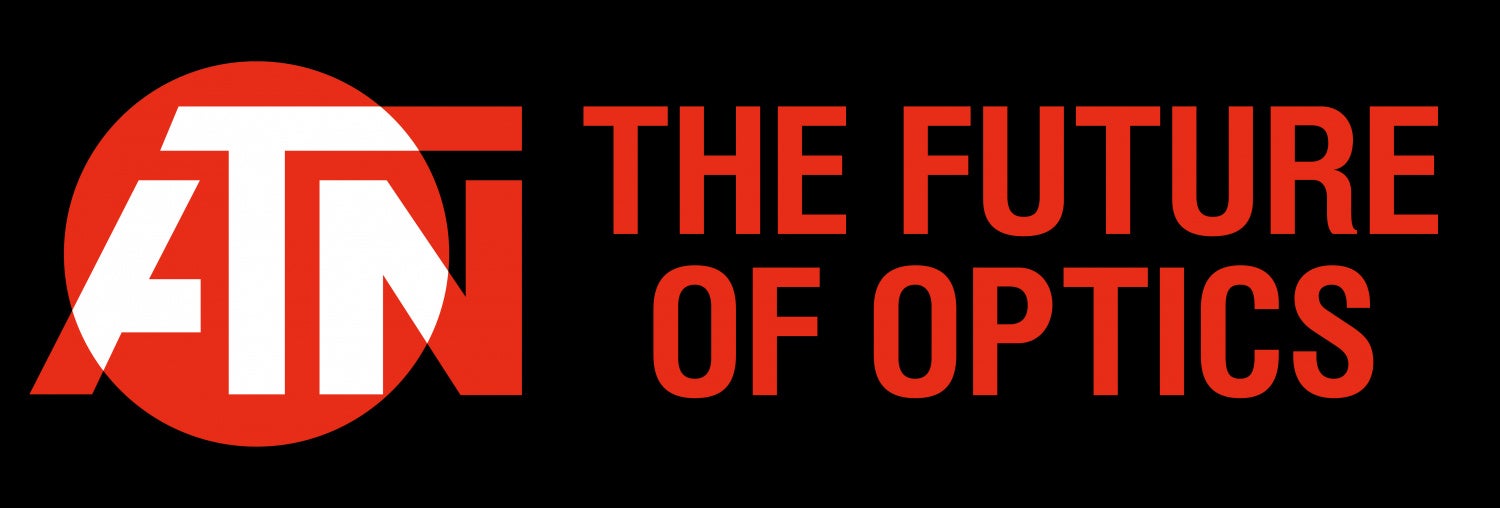Welcome to Friday Night Lights. We are sponsored by ATN ATN Corp, manufacturers of night vision and thermal optics like the THOR LT. As with all of our sponsored series, Friday Night Lights will continue to bring you unbiased news and reviews from a variety of companies. For those who have not heard of Noisefighters, they make gel cups for popular ear pro. Richard L. wrote about them two years ago. Neal Brace, the owner and founder of Noisefighters, has a history of innovating, he created Sinter Core and made 3D printed sintered muzzle devices. He is now delving into the night vision world with his new Panobridge Mk1, a dual PVS-14 bridge that allows the user to have up to 75º panoramic FOV.
Panobridge: Panoramic Binos
So the concept of the Panobridge was experimented with many years ago by Insight Technologies. The PVS-25 was a fixed-angle binocular night vision goggle that looks like it was a modified PVS-15.

Photo provided by Noisefighters
According to Noisefighters, there is no evidence that he has been able to find that the PVS-25 was ever adopted in large numbers. The photo above was shared with him but this was only after he came up with his Panobridge concept. He arrived at a similar conclusion but took the pano binos concept further. The trick or hack to getting wider panoramic FOV in a dual tube goggle is a solid concept. Notice the PVS-25 monocular pods are flared out and not parallel to each other? It actually works. When Noisefighters told me about their Panobridge concept, I immediately tried it with two PVS-14s in my hand. Hold them parallel like normal binos and you see a single 40º FOV circle. Now angle each of the PVS-14s about 15º outwards for a total angle of 30º. According to Noisefigthters, this gives you approximately 75º FOV. Their Panobridge Mk1 has this additional point of articulation. What sets the Noisefighters’ design apart from the PVS-25 is that the monocular pods are not fixed. You can adjust the angle of the panning however you want. They dub it AFOV (Adjustable Field Of View). The AFOV is critical for pupillary distance reasons. Not everyone has the same space between their pupils as others.
Edit: Thanks to @CompassCall for sharing this photo. It looks like L3 is continuing with their WFOV design but implementing it in a BNVD-PVS-31.

At first glance, the Panobridge Mk1 looks like another articulating dual PVS-14 bridge.






What sets the Panobridge Mk1 apart is its ability to pan the PVS-14s outward.


Panobridge MK1 vs TNVC NPBM

The Panobridge is 3D printed. Noisefighters is using high-quality polymer. Neal shared a video where he tried to destroy his bridge. He was unable to break it. This makes it very strong and lightweight. The bridge with metal hardware only weighs 1.4 ounces.

That is less than half the weight of the TNVC NPBM.



Due to the arm design of the Panobridge, the left side PVS-14 cannot articulate as far as the right side. See below, the arm touches the Wilcox G24 mount.


Another minor issue is how tight you tighten the mounting screw. If it is not tightened, there is some play and the PVS-14 can spin a bit around the mounting screw.


Also, you may have noticed he used blue anodized screws for the pre-production sample. He later sent me an updated pre-production version. He will be offering Cerakoted versions for those who do not want black. He had this one coated in RAL-8000.

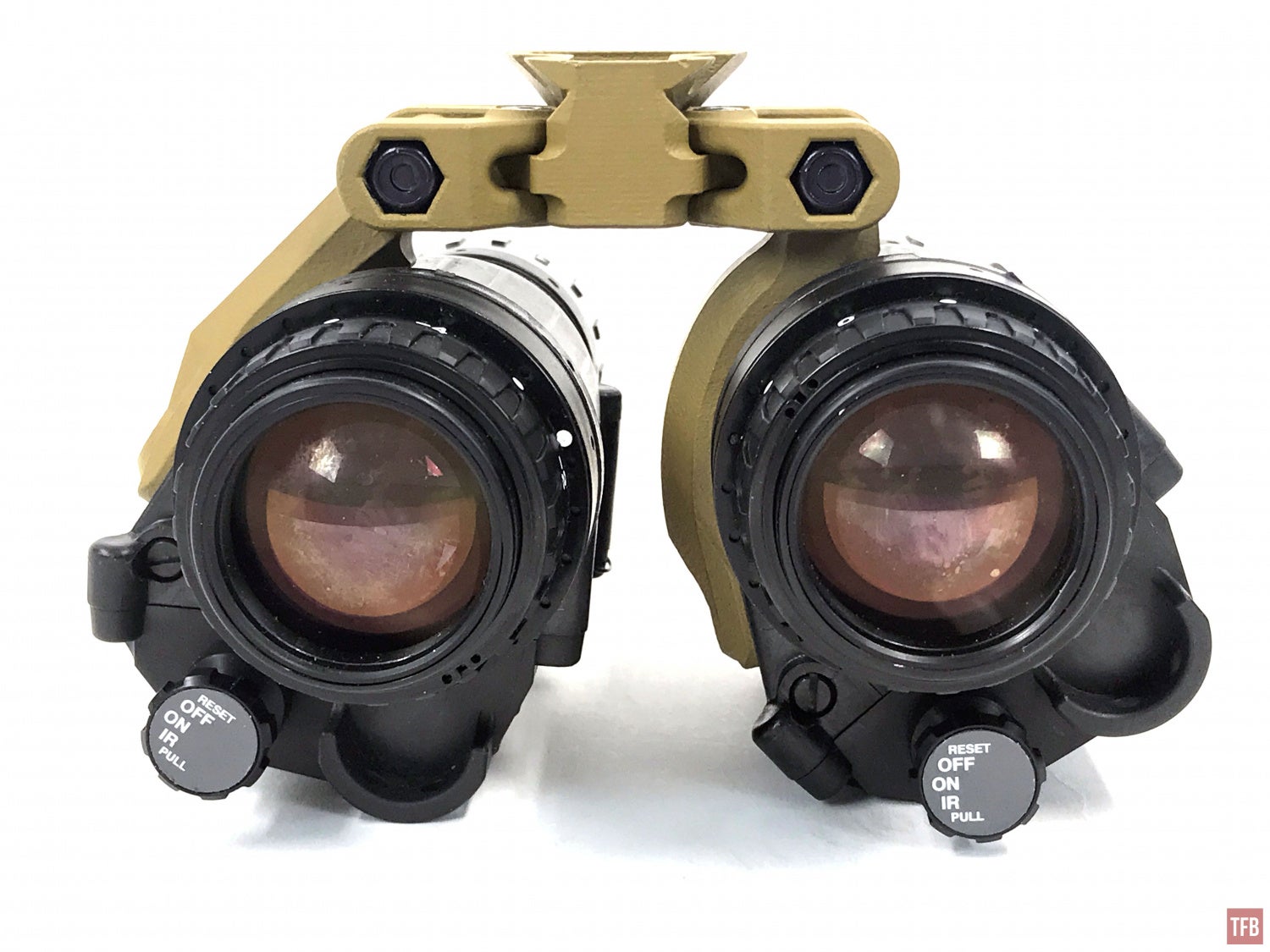



Here you can see the articulation better on the bridge. The bridge has angled stops so the PVS-14s can only be panned out to 15º at most.





Using The Panobridge
So how does this work? Your eyes and brain are very good at merging the separate information from each eye to give us stereopsis (depth perception). Each eye technically sees a different image and they are merged in your brain. By panning the PVS-14s outward you are feeding your eyes more information and your brain merges it into a sideways figure eight. Think of a Venn diagram where you have two overlapping circles. Your eyes are now looking through each eyepiece but at a slight angle.

Left eye

right eye
Here is a simulated sight picture of what my brain shows me.
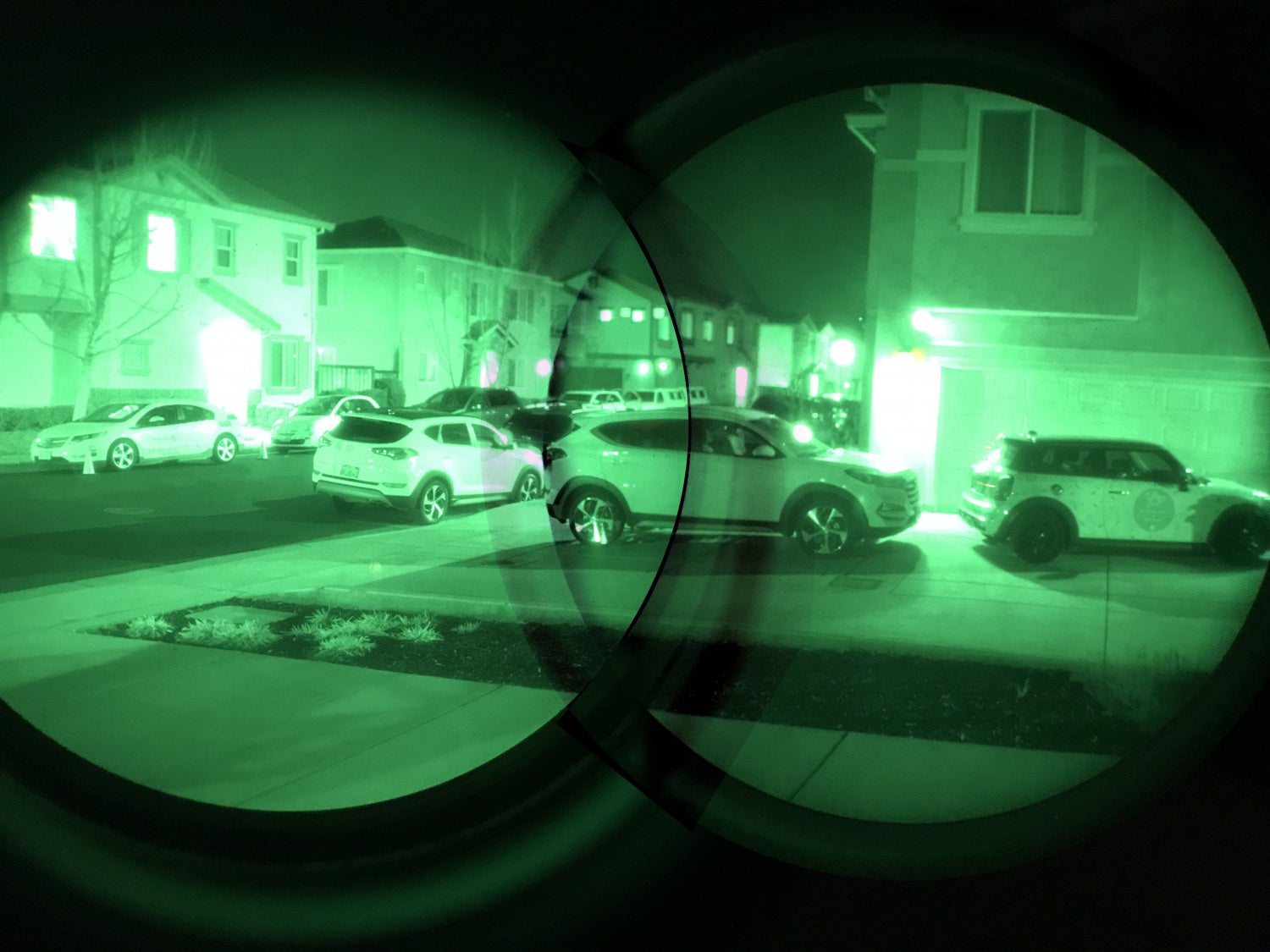
Simulated merged image
In the Venn diagram of PVS-14 images the overlapped middle section, cat’s eye, is binocular vision. Both eyes are seeing the same thing so I experience stereopsis in the middle. The sections outside of it are a bit odd and I lose the sense of depth perception. I tried driving with the Panobridge MK1 flared out and I could definitely see more than normal 40º FOV binos.
There are some minor nuances to using the Panobridge Mk1. While you can see more, your objective lenses are no longer looking straight out in front of you. This makes aiming passively a little more difficult. With a red dot on a handgun, I found it easy to move the red dot into my field of view. With an red dot on a carbine this is a little bit more awkward. In order to aim passively, you need to move your red dot further to the side so the objective lens of your PVS-14 can look through it and feels weird because it is not where you normally position your gun. Of course, you can just use an IR laser to aim without the awkwardness or shift the PVS-14s back to normal 40º FOV. Since the Panobridge is independently articulating, you can adjust the angle of each side to your personal preference. With more time behind this setup, you can get accustomed to the nuances and they no longer become an issue. Just like adjusting to shooting passively with standard dual-tube binos, it takes a little bit of practice to become comfortable and eliminate the awkwardness.
When adjusting the PVS-14s you cannot just simply pivot them outward since the point of articulation is near the middle of the PVS-14s. This brings the eyepieces closer together. So you need to roll the PVS-14s up while you pivot them outward. You may also need to lower your NVG mount since you are rolling the eyepieces up and out a bit. An added benefit to bridge PVS-14s using the Panobridge Mk1 is the ability to see between the two eyepieces.

Photo by Noisefighters
The Noisefighters Panobridge also changes the game by introducing the ability to peer through the gap between laterally-rotated monoculars with an unaided eye to use a handheld thermal imager, or aim pistol sights, or view a scene using ambient light to better gauge distance, texture, color, or lighting. This is similar to the technique provided by using a single PVS-14 on a J-Arm, but it now available for multi-tube use.
See the photo below. This is what my left eye sees. However, my peripheral vision can see the gap between the eyepieces and see normal lighting. I can even hold up a thermal sight like the thermal reflex Echo3. This helps since the Echo3 requires a focal shift to look at the rear display.

Left eye POV.

Right eye POV with SIG Echo3.

When set up properly, this is what my brain interprets and shows me. I can see a ghosted image from the SIG Echo3 on top of my left eye FOV.

You do not have to use PVS-14s. Other monoculars may work. I have confirmed that MOD-3 monoculars will fit the Panobridge but you have to use no-manual gain pods. The manual gain pods will not fit the Panobridge. Below is a new 3D printed battery housing to convert BNVD-1431 pods into monoculars. I will write about these in a future Friday Night Lights article. But for now, these are the lightest bridge monoculars that I know of: 17.3 ounces and that is complete with two batteries.

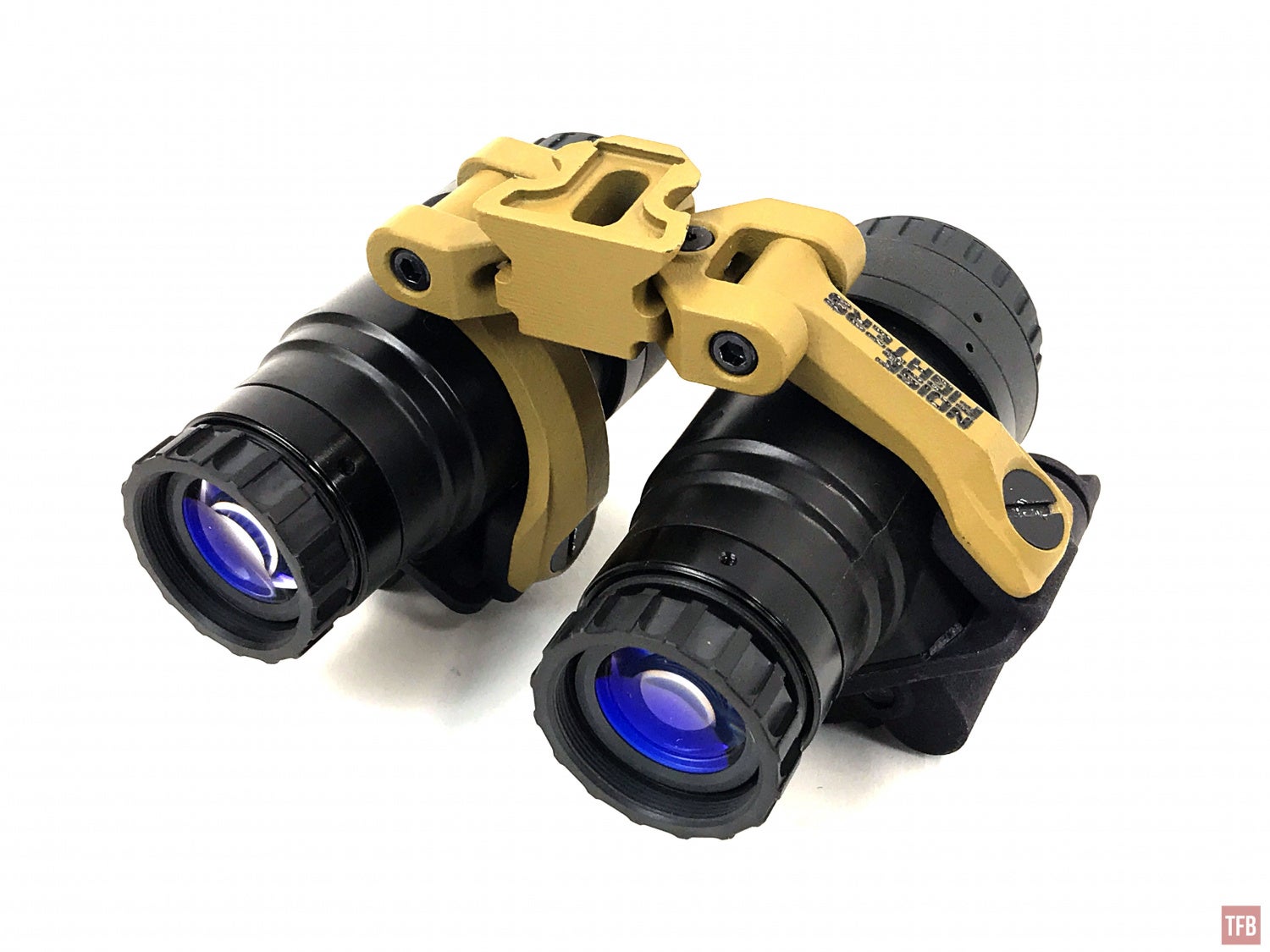

Other Noisefighter Night Vision Products
Besides a panoramic dual PVS-14 bridge, Noisefighters will be coming out with their own take on a dovetail PVS-14 arm. Their X-14 arm is similar to the right arm on their panoramic bridge and it only weighs 0.6oz.
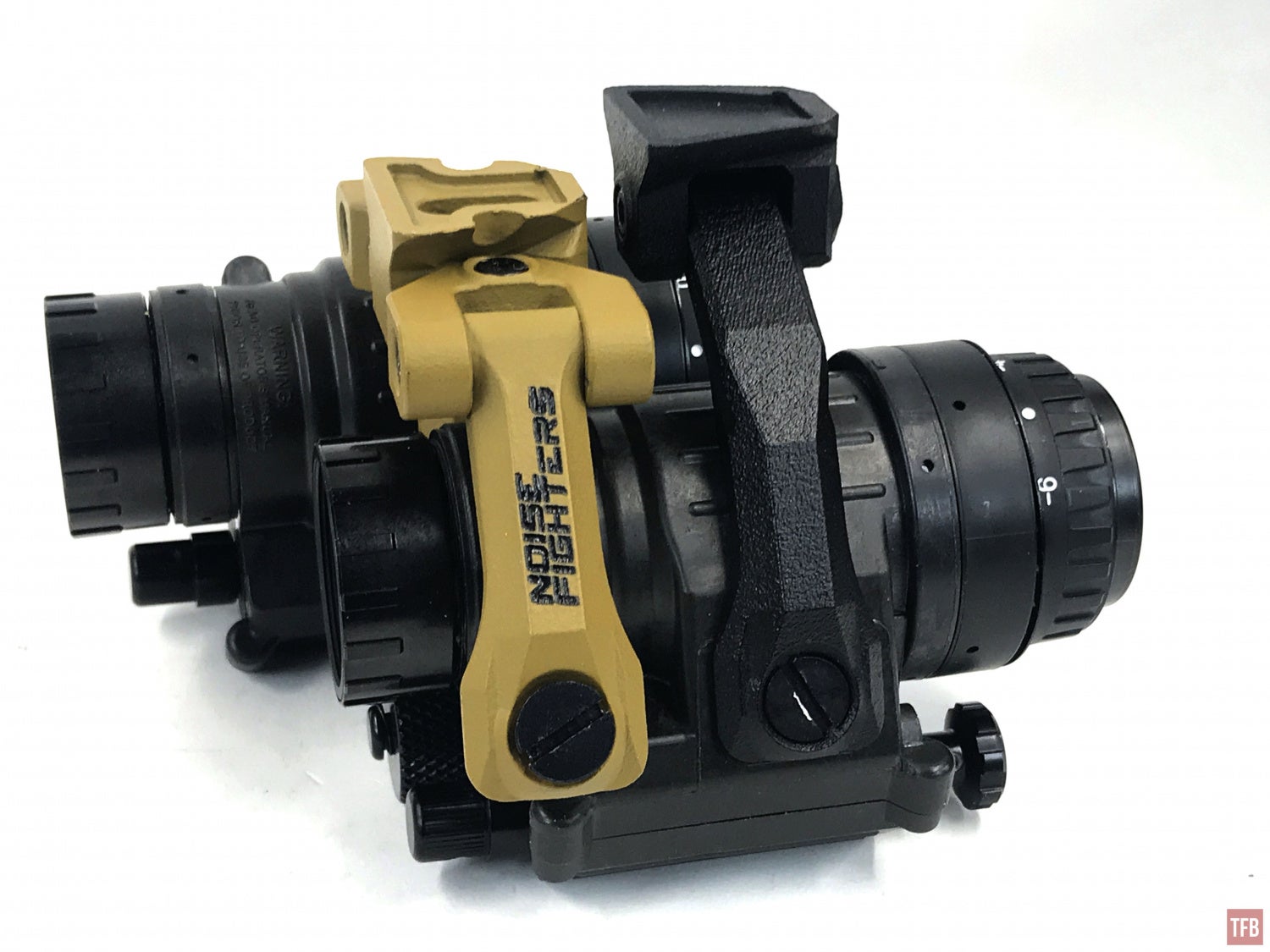
The arm is held in place with friction. And it allows you to swing the PVS-14 from left to right eye without needing to loosen anything or use tools.










This may be the lightest monocular with dovetail J-Arm. That is complete with the battery.
Final Thoughts On Noisefighter’s Panobridge
The concept of the Panobridge is a clever trick and it does work. I was surprised by how effective it is at giving you additional FOV. There is one minor issue and it is not unique to Noisefighters. It is the act of bridging two PVS-14s. The problem is that is very common that the PVS-14s will not be collimated to each other. For some people, this is only an inconvenience since their brains are flexible enough to merge the two images to make a single image. Uncollimated units can give you double vision or cause your eyes and brain to work harder to merge the separate images which might give you headaches or eyestrain. So if you do get a Panobridge it is best to have it sent to someone who can collimate them. This is a minor inconvenience but is better for you in the long run.
The Panobridge will go on sale for $500 on their website. The X-14 dovetail arm, I have been told, will retail for around $100. Neal will also be using lightweight lenses and battery housings from Nightline Inc. They claim a built set of dual PVS-14s with a Panobridge Mk1 will weigh under 20 ounces. And as an additional benefit, run time on the new battery housing is allegedly 70 hours instead of the normal 40 hours off a AA battery. This new battery housing can use both CR123 or AA batteries. Nightline claims the 70 hours is when you use a CR123.
Another promising look into Noisefighters’ night vision line is a dedicated dual-tube bino with their pano articulation. Noisefighters has agreed to collaborate with Jeffrey of Nocturn Industries to bring to market a dedicated articulating panobino. While the Panobridge is cool, you are doubling the weight of dual batteries, dual IR illuminators, dual battery housings and dual power switches. Even the hardware to mount the bridge to the PVS-14s is some weight and a lot of weight could be saved by eliminating all of that.
Neal also recently told me that a large US Agency is currently evaluating the Panobridge and may be adopting them if it passes their evaluation.
The future of night vision is looking to be very interesting and people like Neal are innovating outside the box.
 Your Privacy Choices
Your Privacy Choices

